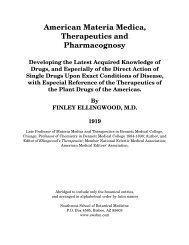SCARLET FEVER. Synonyms.—Scarlatina; Scarlet Rash. Definition ...
SCARLET FEVER. Synonyms.—Scarlatina; Scarlet Rash. Definition ...
SCARLET FEVER. Synonyms.—Scarlatina; Scarlet Rash. Definition ...
Create successful ePaper yourself
Turn your PDF publications into a flip-book with our unique Google optimized e-Paper software.
e infected, even though she presents no signs of the disease.<br />
The most frequent form of transmission is from the father, the mother<br />
being free from infection. This is known as sperm infection. Here, again,<br />
we see strange results; for a decidedly syphilitic father may beget a<br />
healthy child, while, on the other hand, a man, who may have had<br />
syphilis in his early life, but apparently had recovered after treatment,<br />
not presenting a single phase of his old trouble for years, may transmit<br />
to his offspring the characteristic lesion of the disease.<br />
The earlier the offspring is begotten, after the appearance of the<br />
primary sore, the greater the danger from infection, while, under<br />
judicious treatment, the danger is but slight after four years. The more<br />
remote from the initial lesion, the less the danger, and a parent<br />
suffering from tertiary lesion may beget a healthy child.<br />
Infection from the mother, known as germ infection, is also quite<br />
common, the father being free. In most cases, however, both father and<br />
mother are infected, the latter by the former;. in which case the child is<br />
very apt to show infection.<br />
Where the mother becomes infected after conception, the offspring may<br />
show infection, when it is known as placental transmission.<br />
Pathology.—Chancre.—The initial lesion consists of an infiltration of<br />
small round cells, together with larger epithelial cells, giant cells, and<br />
the bacilli of Lustgarten. The inflammatory process causes thickening,<br />
and sometimes obliteration, of the smaller arteries and veins, which give<br />
rise to sclerosis. This is soon followed by degeneration of the epithelium,<br />
causing the small, round, shallow ulcer about the size of a split pea, the<br />
hard, indurated convex surface forming its base. The near lymphatics<br />
are soon involved, becoming infiltrated and indurated, which in turn<br />
may caseate and break down.<br />
Secondary Lesions.—The most common are ulceration of mucous<br />
surfaces and cutaneous eruptions. The favorite location for mucous<br />
patches is the mouth and anus. They vary in size from a pin-point to a<br />
half-dollar, their edges being slightly indurated. Iritis is quite a common<br />
attendant.<br />
Tertiary Lesion.—Inflammatory products, known as gummata,<br />
characterize the third stage. These bodies are made up of round cells,<br />
The Eclectic Practice of Medicine - PART I - Infectious Diseases - Page 218

















